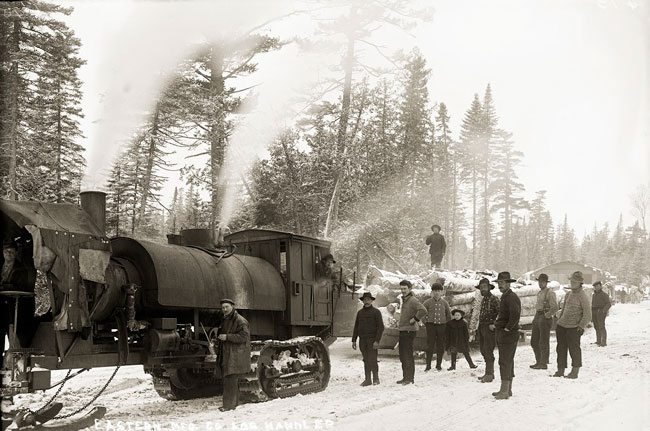B A C K T H E N
Lombards
The Lombard steam log-hauler was invented and manufactured by Waterville’s Alvin O. Lombard. Patented in 1901, it was the first commercially successful track-laying vehicle. Lombard was motivated by the heavy losses of woods horses, laid in part to the increasing demand for birch bolts, which do not float and had to be hauled long distances. Despite the inevitable problems, especially when operating in sub-zero temperatures, Lombards quickly gained favor—one big woods operator claimed that three log-haulers did the work of sixty horses. A 20-ton Lombard could haul 175 tons of birch bolts.
Lombards required improved roads, iced nightly by horse-drawn sprinklers. There were no brakes, and the steersman—or two steersmen, as seen here—was sitting in a very poor place if a train of heavy sleds jackknifed. Log-haulers operated around the clock, their shrill whistles echoing from distant hills on cold, still nights. More than eighty steam Lombards were built at Waterville through 1917. A gasoline-engine version was introduced in 1914.
The story of the bitter patent wars between Benjamin Holt, founder of the Caterpillar Tractor Company, and rivals is too involved to be related here. Perhaps all that Mainers need know is that when the kindly Alvin Lombard was approached to be a friendly witness in a suit brought against Holt by another competitor, he reportedly responded, “By God, young man, I’m glad to see you. If God Almighty could charter me to kill a man, I’d get on the train and go to California and kill old Ben Holt.”
Text by William H. Bunting from Maine On Glass. Published by Tilbury House Publishers, 12 Starr St., Thomaston, Maine. 800-582-1899.
Maine On Glass and prints of the photographs are available through the Penobscot Marine Museum: PenobscotMarineMuseum.org.

